Some years ago I walked into a Christian bookstore, and a fascinating colorful poster immediately caught my eye. From a distance, it looked like an image of the crowned head of Jesus. But as I drew closer, I could see that the whole picture was actually a composite of other tiny faces that made up the lines, contours, and complexion of the larger head and face.
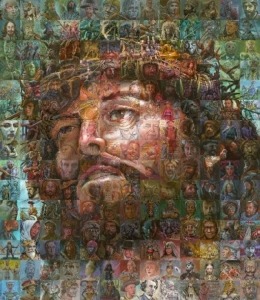 It was a kind of mosaic containing the recognizable faces of people like Gandhi and Martin Luther King and other famous and anonymous people, male and female, young and old. I think I spotted a few white-clad popes in there too.
It was a kind of mosaic containing the recognizable faces of people like Gandhi and Martin Luther King and other famous and anonymous people, male and female, young and old. I think I spotted a few white-clad popes in there too.
The caption on the poster read “One in Christ”, which wasn’t actually correct given the number of non-Christians in the image (alas, the man who painted it was a good artist but a bad theologian).
Still, each little face represented a unique person, and I appreciated his incredible imagination and talent in crafting a portrait like that. I also understood the larger meaning of the image: Jesus had all those individuals—including you and me—in mind when He wore that Crown of Thorns for humanity. Point taken.
(This image is a similar concept but not the same image I saw.)
The Name Petros
I was reminded of that poster one day when I noticed something about the name of our first pope. There is only one man in the Bible named Peter (Petros is the proper name), but as we know, his given name was Simon, and there are a whole bunch of Simons in the Bible.
Maybe I’ve been sitting out in the Florida sun a bit too long, but it struck me that the one Simon Peter was kind of a composite of all those other Simons.
Simon’s name change to Peter, which we find in Matthew’s Gospel (16:17-19) is significant. The name “Petros” has its root in the regular Greek word for “rock” (petra), which was then turned into a proper name that resembled it.
The play on words should be obvious: building a church on a “rock” whose name is “Rock” was a pretty audacious thing. (Please, nobody tell Dwayne “the Rock” Johnson he’s been upstaged.)
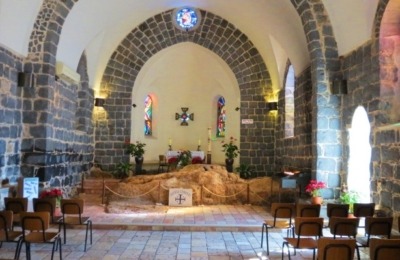 The image here is from the Church of the Primacy of Peter in Capernaum near the Sea of Galilee, which is built around a huge rock and commemorates this event.
The image here is from the Church of the Primacy of Peter in Capernaum near the Sea of Galilee, which is built around a huge rock and commemorates this event.
On a pilgrimage in the late ’80s I remember praying for the pope in front of this rock, and a little bird flew in the side window, perched right in front of me on the rock, chirped once, then flew away. Was it the Holy Spirit? It’s probably the closest I’ve ever gotten to a mystical experience, but I’ll take it that my prayer for the pope was appreciated.
Name changes in the Bible indicate God’s designation of an individual for a new mission. We know of several other name changes that were revolutionary: Abram to Abraham and Sarai to Sarah (Gen 17:4); Jacob to Israel (Gen 35:10); and Saul to Paul, which was a Roman name for his new mission that sent him to every corner of the Roman Empire (Acts 13:9).
So, Peter’s mission too began with a new name that was full of meaning. But what about the old Simon?
Name Frequency in the Bible
We would be hard-pressed to find a name that applies to so many different men in Scripture than the name of Simon, although there are other names that appear more frequently, which is a fascinating study in itself. Here’s the list of the top ten:
-
- Jesus (1,281 times)—yay!
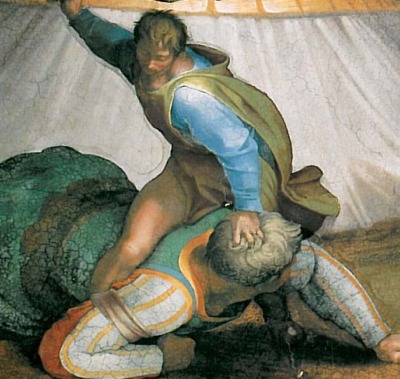
- David (971 times)
- Moses (803 times)
- Jacob (363 times)
- Saul (362 times)—both Old and New Testament Sauls
- Aaron (342 times)
- Abraham (294 times, including 57 as Abram)
- Solomon (272 times)
- Joseph (246 times)—1 Old and 2 New Testament Josephs
- Paul (228 times)
- Jesus (1,281 times)—yay!
(Source: New International Version, H. Culbert; image: Michelangelo’s David Slays Goliath from the Sistine Chapel.)
Of the frequent female names in the Bible, the top three are Sarah (82), Esther (64), and Rachel (58). Our Lady’s name, Mary, is fourth with 57 references, which include Mary Magdalene and Mary, wife of Clopas. Again, fascinating.
As you can see, only a handful of the most frequent names have two or three biblical individuals to whom the name refers. Simon has a dozen.
The Most Diverse Name
Only one other biblical name applies to more unique individuals than the name Simon. Can you guess it? I couldn’t! It’s the name Zechariah, which in Hebrew means “God Remembers”. Like the dozen Simons, the biblical Zechariahs are prolific and quite a diverse lot: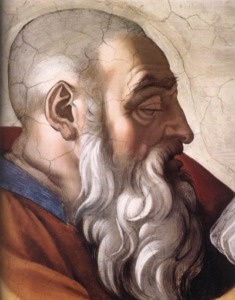
-
- One was a king of Israel (2 Kgs 15)
- One was a prophet (the writer of the biblical book of the same name)
- Another was a priest who was martyred in the Temple (2 Chron 24:21); Jesus actually refers to that Zechariah when reproaching the Pharisees (Mt 23:35).
- And you may recall that John the Baptist’s father was named Zechariah as well (Lk 1:5-25).
In addition, there are at least 18 other individuals in the Old Testament named Zechariah, pushing the total count up to 22 distinct Zechariahs—wow!
(My source for this info is a guy on the Internet named, you guessed it, Zechariah A: nice job, Zach.; image: Michelangelo’s Prophet Zechariah from the Sistine Chapel.)
A Portrait of Simon?
Now to all the Simons. Counting Simon Peter and Simon, the cousin of Jesus (who we know nothing about; see, Mt 13:55; Mk 6:3), there are twelve Simons sprinkled throughout the Bible from Genesis to Acts. Hmmm. A dozen Simons. Could the number 12 be symbolic of anything?
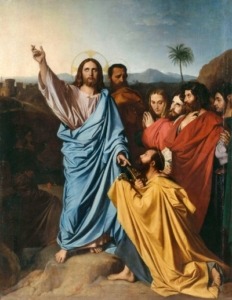 These twelve Simons are starkly different from each other, but I believe their overarching presence in Scripture forms a sort of composite profile of the man who became our first pope.
These twelve Simons are starkly different from each other, but I believe their overarching presence in Scripture forms a sort of composite profile of the man who became our first pope.
The Hebrew name, Shi-mon, means “hearkening” or “listening”, which has a direct bearing on the holder of the papal keys, who is duty-bound to listen to the voice of the Lord and hearken to the pastoral needs of Christ’s flock (Jn 21:15-19).
So let’s look briefly at the other ten Simons of Scripture to see what they have to tell us about Simon Peter and maybe the papal office in general.
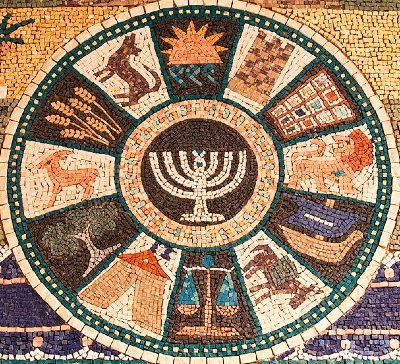
Simeon the Patriarch (Homicidal)
(Genesis 29:33; 34; 42:24; 46:10) – This is the first appearance of the name Simon in Scripture. He was the son of Jacob and Leah and gave his name to one of the Twelve Tribes of Israel. Simeon was virtue-challenged at times: he participated in the plot to sell his brother Joseph into slavery and later rained down violent retribution on an entire city.
Simon Maccabeus (Hero)
(1 Maccabees 13 and 14) – This Simon was the son of the priest Mattathias and the brother of Judas and Jonathan of the Maccabean revolt. He attempted to save Jonathan from death but failed; he did, however, conquer all of Israel’s enemies, purify the Temple and provide for his people. He established the feast of Hanukah and became the first prince of the ruling Hasmonean Dynasty and was called their “leader and high priest forever, until a true prophet arises” (14:41).
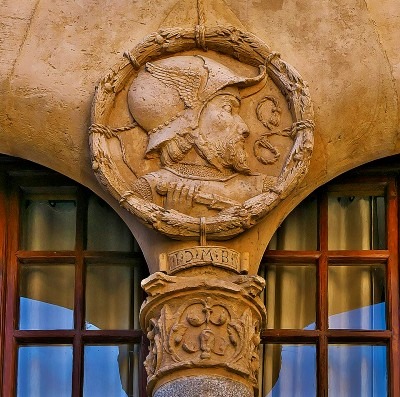
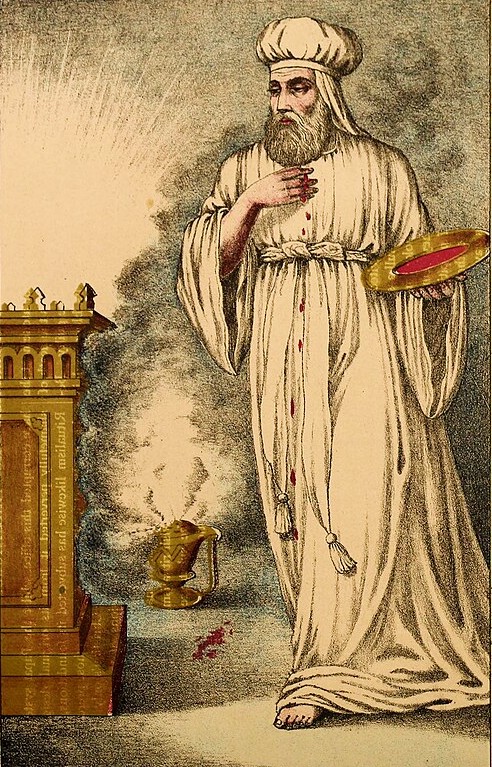
Simon the Villain (Traitor)
(2 Maccabees 3 and 4) – I’ll bet you didn’t know there is a totally wicked Simon in the Bible too. He was a Jewish priest, the superintendent of the Temple under the High Priest Onias, but he wanted the top job. This Simon was a traitor and quarrelsome (3:4); he was a calumniator (3:11), a false witness and a slanderer (4:1-2); he suborned murder and plotted destruction (4:3-4); his wickedness and folly (4:6) caused great damage to the people of Israel.
Simeon the Pious (Saint)
(Luke 2:25–35) – The “just and devout” old man of Jerusalem met Mary and Joseph as they entered the Temple with the Child Jesus. Simeon was led there by the Holy Spirit and prophesied that Christ would be a “sign of contradiction” to His people. He also predicted that a sword of sorrow would pierce Mary’s heart. A holy man if there ever was one.
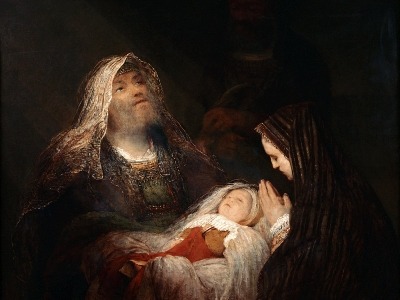
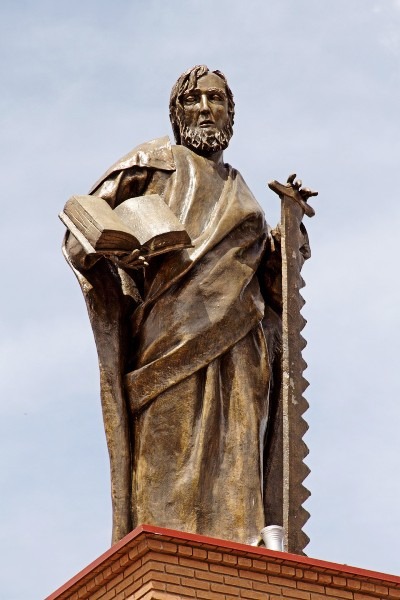
Simon the Zealot (Hothead)
(Matthew 10:4; Mark 3:18; Luke 6:15; Acts 1:13) – This Simon is described as a member of the fanatical Zealot party that violently opposed the Roman occupation of the Jewish homeland; he was chosen by Jesus as one of the twelve apostles perhaps because of that very “zeal”. Tradition has it that he evangelized Egypt with St. Jude Thaddeus and died a martyr by being sawed in two. Ugh.
Simon the Pharisee (Hypocrite)
(Luke 7:36-50) – This Simon is described as “a certain Pharisee” who invited Jesus to dine at his house. When a penitent woman washed the Lord’s feet with her tears, Simon objected, and Jesus in turn used the Pharisee as a bad example of hospitality and hard-heartedness to make a point about divine mercy.
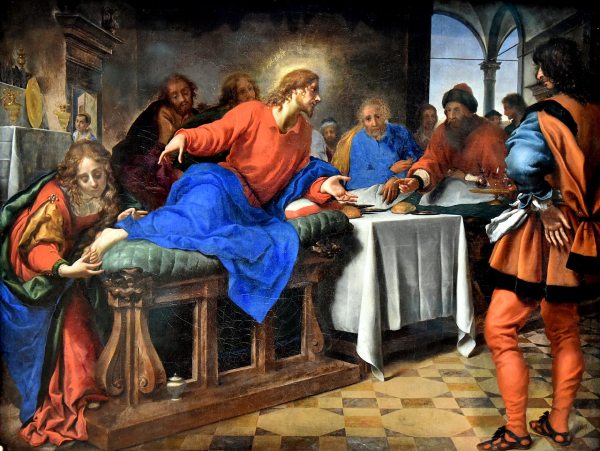
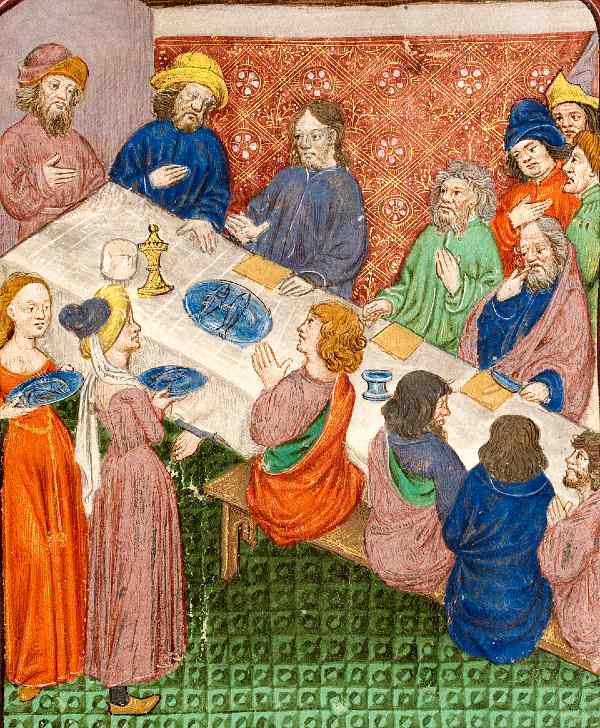
Simon the Leper (Friend)
(Matthew 26:6-13; Mark 14:3-9) – We know little of Simon the Leper other than that he was from Bethany and was Jesus’s friend. The Lord stayed at his house when He visited Jerusalem.
Simon of Cyrene (Reluctant Disciple)
(Matthew 27:32; Mark 15:21-22; Luke 23:26) – This Cyrenian man (from modern-day Libya) was unexpectedly recruited to carry Jesus’ Cross on the way to Calvary. He is mentioned in all the Synoptic Gospels, and in Mark he is called “the father of Alexander and Rufus” (Mk 15:21). Tradition has it that his sons later became Christian missionaries (Rom 16:13). Notice the two boys in the lower right corner of the painting.
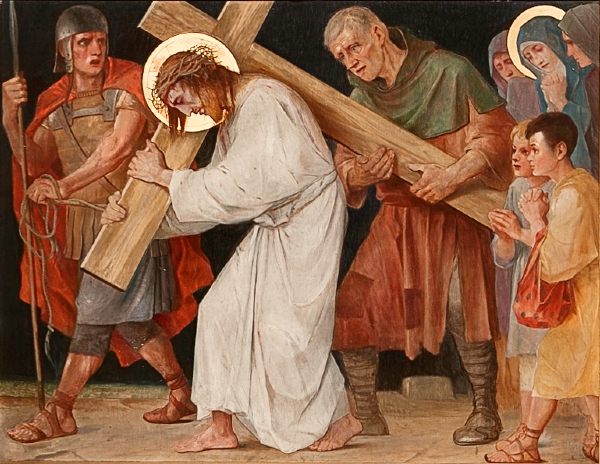
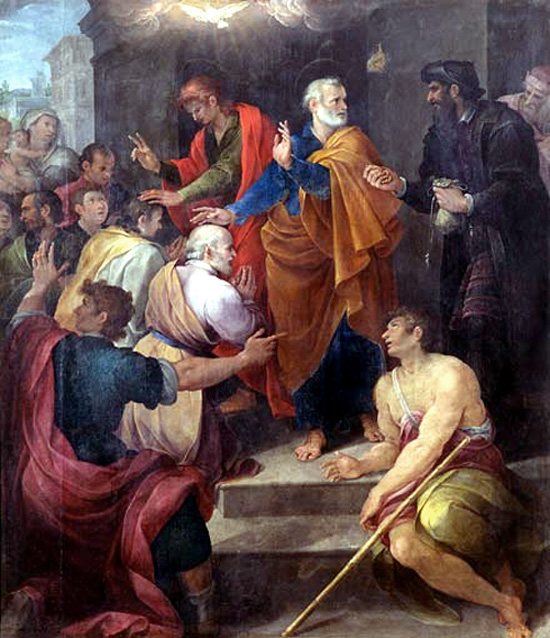
Simon Magus (Misguided)
(Acts 8:9-24) – Simon the Magician was a sorcerer from Samaria who was baptized by the Apostle Philip. He was insufficiently converted and later attempted to “purchase” spiritual power from the apostles. Because of this, the name simony is applied to the sin of buying and selling sacred things in the Church. He was severely rebuked by St. Peter, but to his credit, he also repented (v. 24).
Simon the Tanner (Early Disciple)
(Acts 10) – We know little about this Simon except that he was a tanner of leather and that he hosted St. Peter “for a considerable length of time” (Acts 9:43). It was in his home that Peter had a vision in which God instructed him to open the doors of the Church to the Gentiles. The Roman centurion Cornelius was told by an angel to send emissaries to find Peter at Simon’s house.
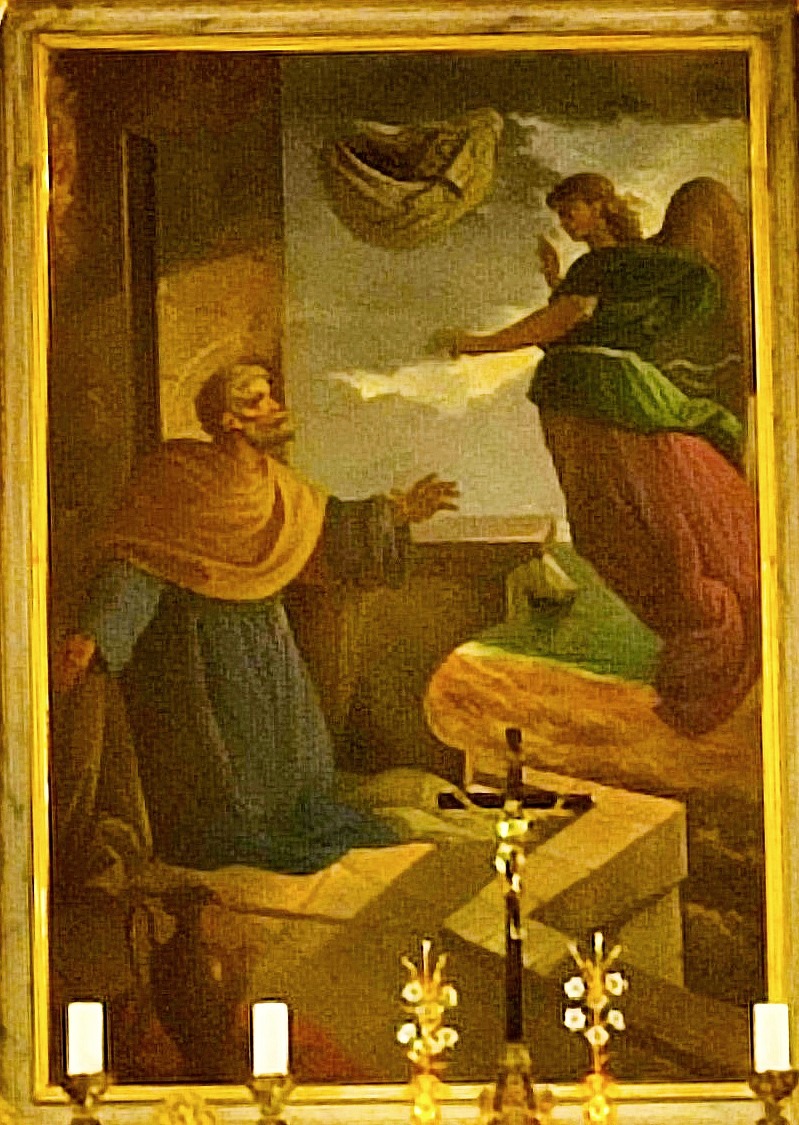
An Incredible Portrait
So, as you can see, the incredible variety of Simons paints quite a picture, doesn’t it? Could they be a sort of biblical composite of the first pope? I think so.
When the great apostle was acting out of human weakness, Jesus often called him by his given name: “Simon, Simon, behold Satan has demanded to sift you like wheat” (Luke 22:31). Many of the man’s faults have been captured in the pages of Scripture for future ages of Christians to lament: impetuousness, pettiness, timidity, even betrayal.
But when he transcended his weakness and put his own idiosyncrasies behind him in order to embrace the duties of his office, he became Peter, the Rock. It was this man who rebounded from his personal failings to shepherd the sheep of Christ’s flock and ultimately to die on a cross for Him.
Patriarch, sinner, leader, hypocrite, hothead, holy man, traitor, or apostle: they’re all part of the image we have of a fallible man who was given an infallible office. But we must not get caught up in the fallible Simon part.
There is only one Peter. Upon that Rock Christ built His Church – and the gates of Hell shall never prevail against it.
———-
[Note: This article is a reproduction of the Sacred Windows Email Newsletter of 4/6/25. Please visit our Newsletter Archives.]
Photo Credits:
via Wikimedia Commons: Face of Jesus (Pinterest); Michelangelo (Zechariah and David); Primacy Church (Hoshvilim); Jesus gives the Keys to Peter (Jean-Auguste-Dominique Ingres); St. Peter’s Basilica at Night (Bradley Weber); 12 Tribes Mosaic (zeevveez from Jerusalem); Simon Maccabeus (Jl FilpoC); Simon the Villain (public domain); Simon the Zealot (© José Luiz Bernardes Ribeiro); Simon the Leper (National Library of Wales); Simon of Cyrene (Albin and Paul Windhausen); Simon the Pharisee (Carlo Dolci); Simon the Tanner (Dobroš); Simeon the Pious (Arent de Gelder).

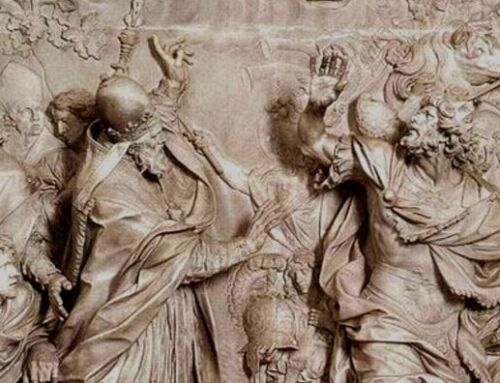
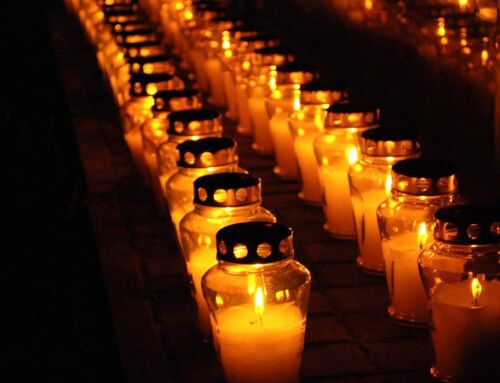
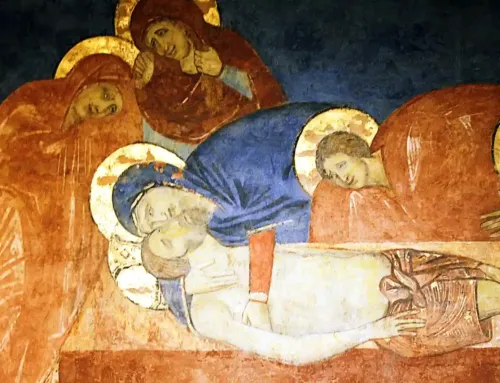
Leave A Comment